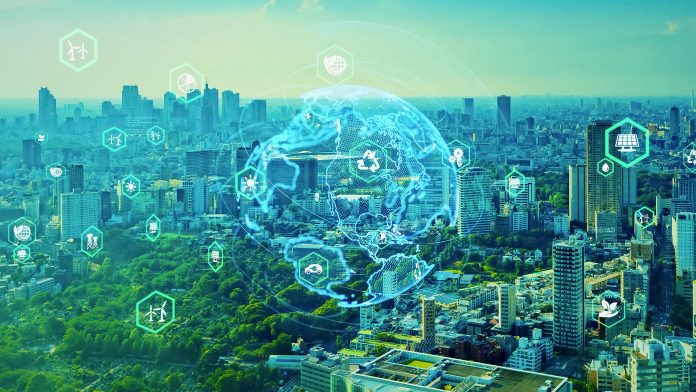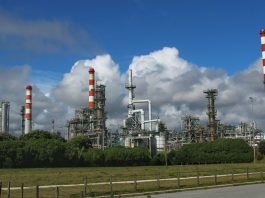Explore the future of urban living with smart city advancements in waste management and air quality monitoring.
The concept of the ‘smart city’ has emerged as an innovative approach to urban planning and development, embodying a range of strategies aimed at improving quality of life, efficiency of services, and sustainability. Among these strategies are smart waste management and air quality monitoring systems, which employ advanced technologies to optimise resource use, reduce environmental impact, and safeguard public health. These systems represent significant advancements in our capacity to manage urban environments effectively.
In particular, smart air quality monitoring allows for real-time detection and tracking of various pollutants that can harm human health or contribute to climate change – from particulate matter and nitrogen dioxide to ground-level ozone.
Concurrently, smart waste management leverages technology to streamline waste collection processes while opening avenues for recycling and other forms of recovery within the circular economy model. Together, these two aspects form an integral part of smart city infrastructure aiming at enhancing urban sustainability and resilience.
What is a smart city?
A smart city, a metaphorical beacon of technological advancement, refers to an urban area that integrates various digital and electronic information technologies into infrastructural elements, thereby enhancing the quality of life for its residents while improving sustainability.
Key facets such as urban connectivity and digital infrastructure form the backbone of these smart cities.
Urban connectivity is about creating an interconnected network where data flows seamlessly among citizens, devices, and systems. On the other hand, digital infrastructure involves implementing cutting-edge technologies like Internet of Things (IoT), Artificial Intelligence (AI), and Big Data Analysis to gather valuable insights from vast amounts of data generated in a city.
Smart transportation and energy efficiency are two major components that significantly contribute to shaping a smart city. For instance, smart transportation employs technology-driven solutions to optimise traffic flow management, reduce congestion and emissions thus promoting eco-friendly transportation methods. This might include real-time traffic updates using cloud-based software or advanced transport systems such as autonomous vehicles powered by AI technology.

Energy efficiency is another critical aspect which can be achieved through innovative solutions like smart grids that use sensors to optimise energy distribution based on demand patterns or intelligent lighting systems that adjust brightness according to natural light conditions.
Citizen participation remains pivotal in the successful evolution of a smart city. It involves engaging residents in decision-making processes through platforms such as mobile applications or online portals where they can voice their opinions or report issues directly related to their community’s wellbeing and development.
Furthermore, city administrators can tap into this collective intelligence for better policymaking or problem-solving strategies thus fostering a more responsive governance mechanism. Therefore, a true smart city transcends beyond just being technologically advanced; it leverages digital innovation for sustainable growth while ensuring enhanced citizen engagement for improved municipal services delivery.
What types of pollutants can smart air quality monitoring systems detect?
Harnessing the power of advanced technology, these innovative systems can detect a wide range of pollutants such as carbon monoxide, sulphur dioxide, nitrogen dioxide, particulate matter and volatile organic compounds.
Pollutant identification in smart air quality monitoring systems is typically achieved through sensors that respond to the physical or chemical properties of the targeted pollutant. These detection methods are designed with sophisticated algorithms which recognise unique patterns or signatures associated with each specific type of pollutant. This not only enables accurate detection but also helps in differentiating between various pollutants present in the atmosphere.
The accuracy of monitoring is a critical aspect of these smart air quality systems. It is ensured by employing high-precision sensors and effective data analysis techniques that minimise errors and false readings.
However, like any other electronic device, system maintenance plays an integral role in maintaining this level of accuracy over time. Regular calibration checks, sensor replacements when necessary and software updates form part of this crucial upkeep process to ensure optimal functioning.

Policy implications arising from the use of smart air quality monitoring systems are profound. By providing real-time and precise pollutant data, these systems serve as a valuable resource for policy makers in formulating effective environmental policies. They help to pinpoint pollution hotspots in cities for targeted interventions while also enabling tracking progress towards cleaner air goals set by local governments or international bodies alike.
Thus, they play a significant role not only in detecting pollutants but also shaping strategies aimed at improving urban air quality.
What are the benefits of smart air quality monitoring?
Innovative detection systems for environmental pollutants offer substantial benefits, particularly in the realm of public health, by providing accurate and real-time data that can inform measures to reduce exposure and mitigate health risks.
The technology advancements in these smart air quality monitoring tools have increased their accuracy considerably, enabling precise identification and quantification of various pollutants. These developments allow for an immediate response to any dangerous spikes in pollutant levels, thus reducing potential harm to residents’ health.
Moreover, regular monitoring aids in identifying patterns or trends over time which are crucial for effective policymaking.
Another significant advantage lies in community engagement – the display of real-time data on public platforms raises awareness about environmental issues among citizens. This transparency encourages people to participate actively in strategies aimed at improving air quality such as waste management initiatives or tree-planting drives.
Furthermore, it opens avenues for collaboration between policymakers, researchers, healthcare professionals, and the general populace who all stand to gain from improved air quality.
Therefore, the integration of smart air quality monitoring systems into urban infrastructure is not just a technological advancement; it represents a comprehensive approach towards healthier communities.
How does smart waste management contribute to the circular economy?
‘Turning trash into treasure,’ as the old adage goes, encapsulates how digitised waste disposal systems can facilitate a circular economy. The integration of technology into waste management allows for more effective sorting, recycling, and repurposing of discarded materials thus promoting the idea of a closed-loop system where waste is not an end product but a resource.
The impact of such waste digitisation impact is manifold including curbing pollution, reducing landfill waste, conserving resources, and creating jobs.
- Circular economy advantages: Digital tools in waste management contribute to the circular economy by improving efficiency in resource use and minimising environmental degradation. They enable precise tracking of waste streams which fosters better decision-making regarding disposal or recycling strategies.
- Recycling innovation: Technological advancements have brought about innovative solutions for managing different types of wastes. For instance, organic wastes can be converted to biofuels while electronic wastes are mined for precious metals.
- Enhanced sustainability: Digitised waste management promotes sustainability by reducing the demand for raw materials through increased recycling rates and fostering energy conservation and carbon emissions reduction.
- Renewable energy utilisation: Waste-to-energy technologies convert non-recyclable waste into heat, electricity or fuel providing renewable sources that reduce dependency on fossil fuels.

The role of smart technologies in transforming our approach towards handling refuse is pivotal not only for environmental preservation but also for economic growth and social development – hallmarks of sustainable societies.
As we strive to create smarter cities that are efficient and eco-friendly, it’s important to understand that achieving enhanced sustainability requires collective effort from all stakeholders – government bodies, private sector entities, communities as well as individuals who generate waste daily. This includes active participation in proper segregation at source which facilitates easier recycling processes down the line thereby promoting circular economy advantages further.
It’s clear then that integrating digital tools within our city infrastructure promises significant strides in our journey towards renewable energy utilisation and a cleaner, more sustainable future.
What are some innovative waste treatment technologies used in smart cities?
Several ground-breaking technologies are revolutionising the way waste is treated in urban areas, helping to create more sustainable and efficient communities. One example of such technology is waste sorting robots, which use Machine Learning algorithms and sophisticated sensor systems to separate different types of waste accurately. This not only improves the efficiency of waste management but also enhances recycling rates by ensuring that recyclable materials are properly sorted and not contaminated with other types of waste.
Similarly, intelligent bin systems equipped with sensors help monitor the level of trash in real-time and provide alerts when they need emptying, thus optimising collection routes and schedules.
The implementation of advanced recycling strategies also plays a significant role in innovative waste treatment. These strategies include processes like pyrolysis, which breaks down organic material into bio-oil or gas under high temperatures without combustion. This method can handle multiple types of waste simultaneously, making it ideal for large-scale operations.
Furthermore, these advanced strategies often involve using automatic sorting equipment capable of separating different kinds of materials based on their physical properties such as weight or magnetic attraction.
Waste-to-energy conversion is another promising approach applied in smart cities to manage solid wastes effectively while producing clean energy. This process involves converting non-recyclable wastes into usable heat, electricity or fuel through various processes including combustion, gasification, anaerobic digestion among others – reducing landfill usage and carbon emissions concurrently.
On the other hand, innovative composting methods are being utilised to reduce organic wastes while enhancing soil fertility. These methods range from vermicomposting (using earthworms) to bokashi (a Japanese method involving fermentation), each offering distinct benefits for managing organic wastes within a smart city ecosystem efficiently while contributing positively towards environmental sustainability.
How can smart waste management and smart air quality monitoring be integrated as part of an efficient smart city system?
Harnessing the power of advanced technologies, it is possible to create a seamlessly interconnected system where meticulous trash handling aligns with vigilant tracking of atmospheric cleanliness. This can be achieved through an intelligent infrastructure that integrates smart waste management and air quality monitoring systems.
Sustainable development relies on this integration, as efficient waste treatment reduces pollution and improves air quality. Such a system could leverage Internet-of-Things (IoT) applications to collect real-time data from various sensors installed in strategic locations throughout the city.
The second stage involves careful data analysis of the collected information. The sophisticated analytics platform would identify trends, patterns and anomalies in both waste generation and air pollution levels, providing valuable insights for decision-making processes. Technology integration plays a pivotal role here by enabling cross-platform communication between different systems within the smart city framework.
Furthermore, predictive algorithms could be utilized to forecast future waste generation rates or potential spikes in pollution levels.
This integrated approach not only enhances urban environmental health but also promotes sustainable living among citizens by fostering awareness about responsible consumption habits and their impact on air quality.
Simultaneously, such a framework facilitates government bodies and related institutions in designing effective strategies for waste management while maintaining optimal air quality standards.
Thus, integrating smart waste management with air quality monitoring forms an integral part of an efficient smart city system – one that promises healthier cities while ensuring minimal ecological footprint.









